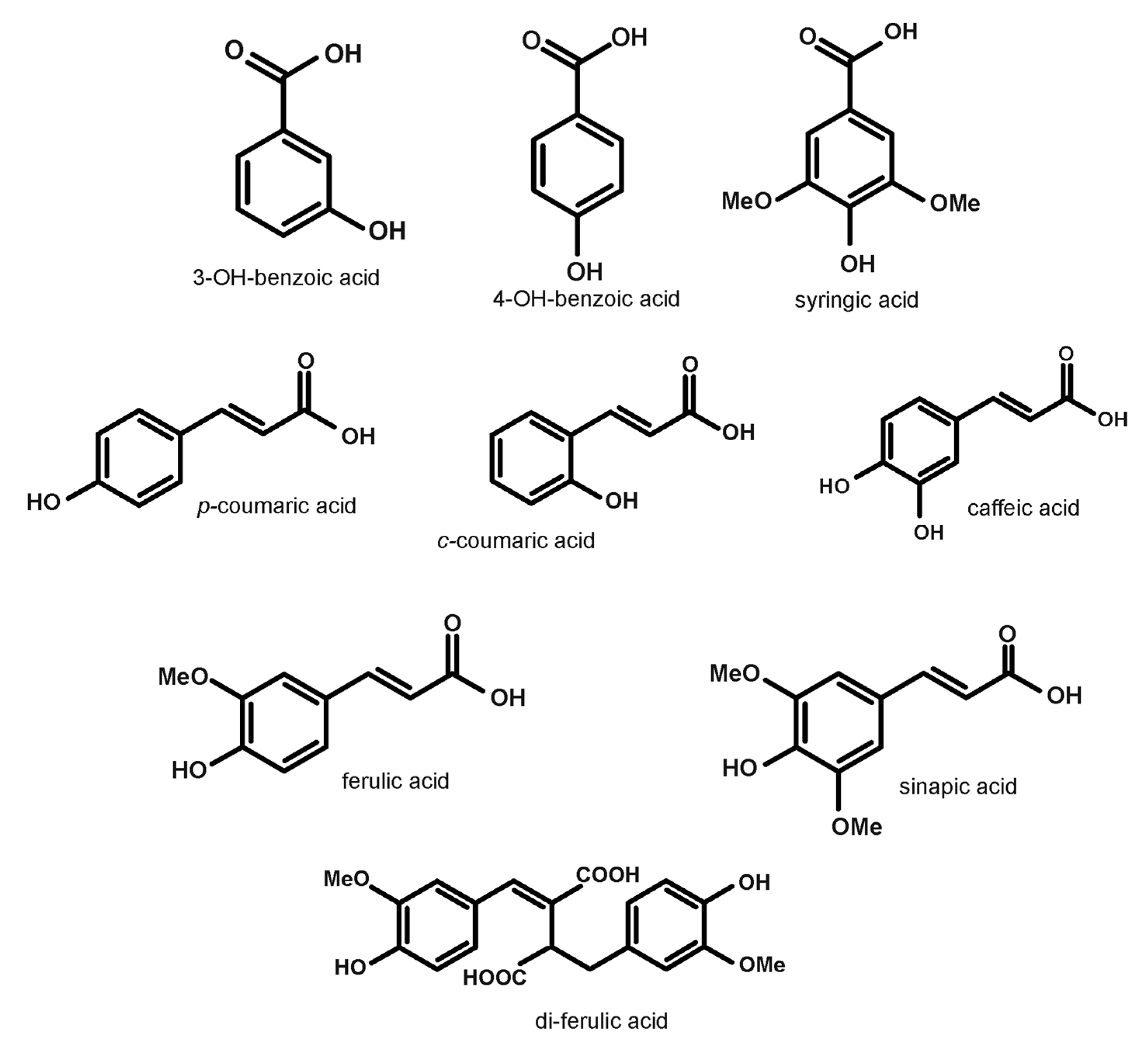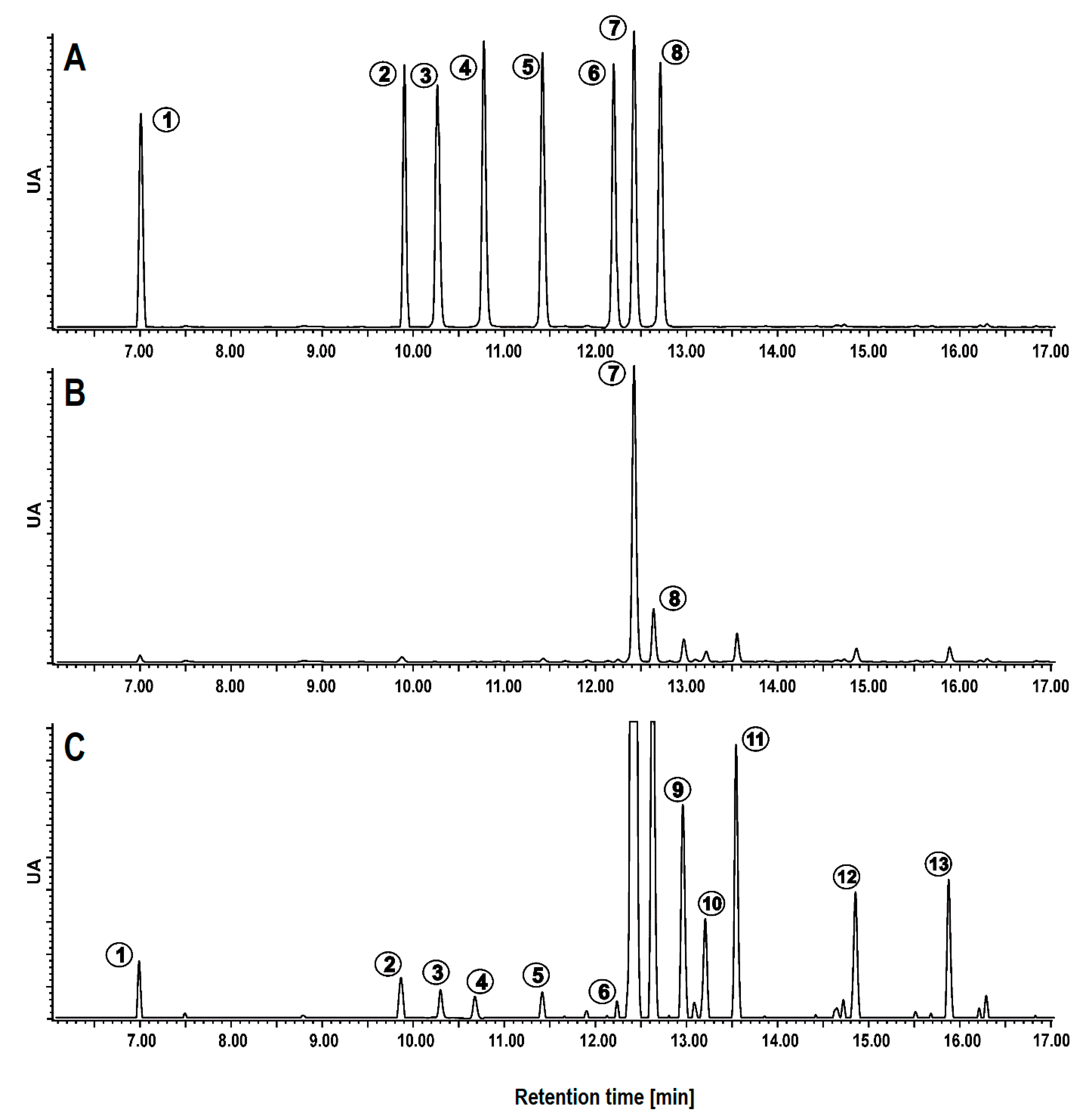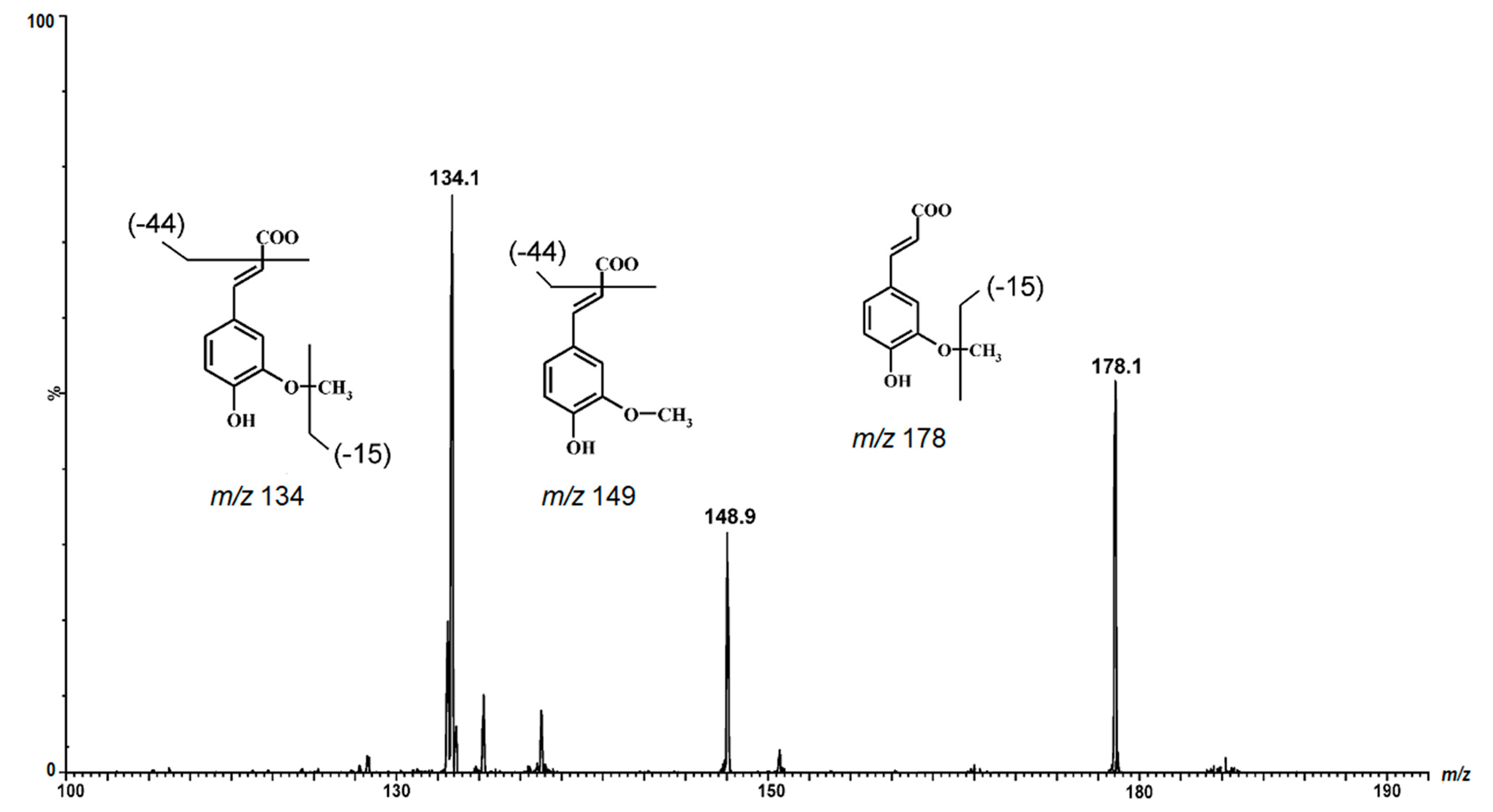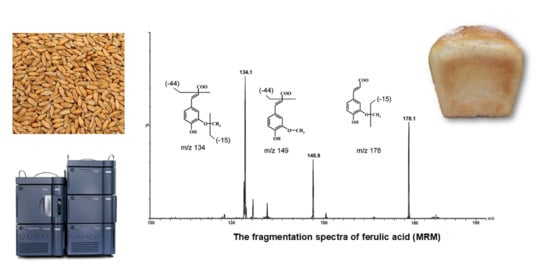Content of Phenolic Acids in the Grain of Selected Polish Triticale Cultivars and Its Products
Abstract
1. Introduction
2. Results and Discussion
2.1. Identification of Phenolic Acids in the Triticale Grain and Its Products
2.2. Content of Phenolic Acids in the Grain
2.3. Content of Ferulic Acid in Triticale Products
3. Materials and Methods
3.1. Materials
3.2. Methods
3.2.1. Process of Grain-Milling
3.2.2. Determination of Water Absorption of Flour
3.2.3. Bread-Baking Procedure
3.2.4. Extraction and Separation of Phenolic Acids
3.2.5. Identification of Phenolic Acids
3.2.6. Quantitative Analysis of Phenolic Acids
3.3. Statistical Analysis of Results
4. Conclusions
Supplementary Materials
Author Contributions
Funding
Institutional Review Board Statement
Informed Consent Statement
Data Availability Statement
Acknowledgments
Conflicts of Interest
Sample Availability
References
- FAO. Food and Agriculture Organization of the United Nations, Statistical Databases. 2018. Available online: http://faostat.fao.org/ (accessed on 18 November 2020).
- McGoverin, C.M.; Snyders, F.; Muller, N.; Botes, W.; Fox, G.; Manley, M. A review of triticale uses and the effect of growth environment on grain quality. J. Sci. Food Agric. 2011, 91, 1155–1165. [Google Scholar] [CrossRef] [PubMed]
- Glamočlija, N.; Starčević, M.; Ćirić, J.; Šefer, D.; Glišić, M.; Baltić, M.; Markovic, R.; Spasic, M.; Glamočlija, Đ. The importance of triticale in animal nutrition. Vet. J. Repub. Srp. 2018, 18, 73–94. [Google Scholar] [CrossRef]
- Langó, B.; Bóna, L.; Ács, E.; Tömösközi, S. Nutritional features of triticale as affected by genotype, crop year, and location. Acta Aliment. 2017, 46, 238–245. [Google Scholar] [CrossRef]
- Sabovics, M.; Straumite, E.; Galoburda, R.R. The influence of baking temperature on the quality of triticale bread. In Proceedings of the Ninth Baltic Conference on Food Science and Technology “Food for Consumer Well-Being” Foodbalt 2014 Conference Proceedings, Jelgava, Latvia, 8–9 May 2014; LLU Faculty of food Technology: Jelgava, Latvia, 2014; pp. 228–233. [Google Scholar]
- Fraś, A.; Gołębiewska, K.; Gołębiewski, D.; Mańkowski, D.R.; Boros, D.; Szecówka, P. Variability in the chemical composition of triticale grain, flour and bread. J. Cereal Sci. 2016, 71, 66–72. [Google Scholar] [CrossRef]
- Woś, H.; Brzeziński, W. Triticale for food−the quality driver. In Triticale; Springer: Cham, Switzerland, 2015; pp. 213–232. [Google Scholar]
- Zhu, F. Triticale: Nutritional composition and food uses. Food Chem. 2018, 241, 468–479. [Google Scholar] [CrossRef]
- Hosseinian, F.; Mazza, G. Triticale bran and straw: Potential new sources of phenolic acids, proanthocyanidins, and lignans. J. Funct. Foods 2009, 1, 57–64. [Google Scholar] [CrossRef]
- Jonnala, R.S.; Irmak, S.; MacRitchie, F.; Bean, S.R. Phenolics in the bran of waxy wheat and triticale lines. J. Cereal Sci. 2010, 52, 509–515. [Google Scholar] [CrossRef]
- Athukorala, Y.; Hosseinian, F.; Mazza, G. Extraction and fractionation of alkylresorcinols from triticale bran by two-step supercritical carbon dioxide. LWT-Food Sci. Technol. 2010, 43, 660–665. [Google Scholar] [CrossRef]
- Boros, D.; Jabłonka, O.; Myszka, K. Triticale as a source of nutrients and bioactive components−study based on chemical characteristics of 29 varieties currently registered in Poland. In Proceedings of the Abstract Book of the 8th International Triticale Symposium, Ghent, Belgium, 10–14 June 2013; p. 47. [Google Scholar]
- Kandil, A.; Li, J.; Vasanthan, T.; Bressler, D.C. Phenolic Acids in Some Cereal Grains and Their Inhibitory Effect on Starch Liquefaction and Saccharification. J. Agric. Food Chem. 2012, 60, 8444–8449. [Google Scholar] [CrossRef]
- Luís, Â.; Domingues, F.; Duarte, A.P. Biological Properties of Plant-Derived Alkylresorcinols: Mini-Review. Mini-Rev. Med. Chem. 2016, 16, 851–854. [Google Scholar] [CrossRef]
- Irakli, M.; Samanidou, V.F.; Biliaderis, C.G.; Papadoyannis, I.N. Development and validation of an HPLC-method for determination of free and bound phenolic acids in cereals after solid-phase extraction. Food Chem. 2012, 134, 1624–1632. [Google Scholar] [CrossRef] [PubMed]
- Zhu, F. Interactions between cell wall polysaccharides and polyphenols. Crit. Rev. Food Sci. Nutr. 2018, 58, 1808–1831. [Google Scholar] [CrossRef] [PubMed]
- Menga, V.; Fares, C.; Troccoli, A.; Cattivelli, L.; Baiano, A. Effects of genotype, location and baking on the phenolic content and some antioxidant properties of cereal species. Int. J. Food Sci. Technol. 2009, 45, 7–16. [Google Scholar] [CrossRef]
- Grúz, J.; Novák, O.; Strnad, M. Rapid analysis of phenolic acids in beverages by UPLC–MS/MS. Food Chem. 2008, 111, 789–794. [Google Scholar] [CrossRef]
- Parejo, I.; Jauregui, O.; Sánchez-Rabaneda, F.; Viladomat, F.; Bastida, J.; Codina, C. Separation and characterization of phenolic compounds in fennel (Foeniculum vulgare) using liquid chromatography negative electrospray ionization tandem mass spectrometry. J. Agric. Food Chem. 2004, 52, 3679–3687. [Google Scholar] [CrossRef]
- Vismeh, R.; Lu, F.; Chundawat, S.P.; Humpula, J.F.; Azarpira, A.; Balan, V.; Dale, B.E.; Ralph, J.; Jones, A.D. Profiling of diferulates (plant cell wall cross-linkers) using ultrahigh-performance liquid chromatography-tandem mass spectrometry. Analyst 2013, 138, 6683–6692. [Google Scholar] [CrossRef]
- Rice-Evans, C.A.; Miller, N.J.; Paganga, G. Structure-antioxidant activity relationships of flavonoids and phenolic acids. Free Radic. Biol. Med. 1996, 20, 933–956. [Google Scholar] [CrossRef]
- Zielinski, H. Low molecular weight antioxidants in the cereal grains—A review. Pol. J. Food Nutr. Sci. 2002, 1, 3–9. [Google Scholar]
- Mattila, P.; Pihlava, J.-M.; Hellström, J. Contents of Phenolic Acids, Alkyl- and Alkenylresorcinols, and Avenanthramides in Commercial Grain Products. J. Agric. Food Chem. 2005, 53, 8290–8295. [Google Scholar] [CrossRef]
- Guo, W.; Beta, T. Phenolic acid composition and antioxidant potential of insoluble and soluble dietary fibre extracts derived from select whole-grain cereals. Food Res. Int. 2013, 51, 518–525. [Google Scholar] [CrossRef]
- Gallardo, C.; Jiménez, L.; García-Conesa, M.-T. Hydroxycinnamic acid composition and in vitro antioxidant activity of selected grain fractions. Food Chem. 2006, 99, 455–463. [Google Scholar] [CrossRef]
- Liyana-Pathirana, C.M.; Shahidi, F. The antioxidant potential of milling fractions from breadwheat and durum. J. Cereal Sci. 2007, 45, 238–247. [Google Scholar] [CrossRef]
- Andreasen, M.F.; Christensen, L.P.; Meyer, A.S.; Hansen, Å. Content of phenolic acids and ferulic acid dehydrodimers in 17 Rye (Secale cereale L.) varieties. J. Agric. Food Chem. 2000, 48, 2837–2842. [Google Scholar] [CrossRef] [PubMed]
- Weidner, S.; Amarowicz, R.; Karamać, M.; Dabrowski, G. Phenolic acids in caryopses of two cultivars of wheat, rye and triticale that display different resistance to pre-harvest sprouting. Eur. Food Res. Technol. 1999, 210, 109–113. [Google Scholar] [CrossRef]
- Li, L.; Shewry, P.R.; Ward, J.L. Phenolic Acids in Wheat Varieties in the HEALTHGRAIN Diversity Screen. J. Agric. Food Chem. 2008, 56, 9732–9739. [Google Scholar] [CrossRef]
- Nyström, L.; Lampi, A.-M.; Andersson, A.A.M.; Kamal-Eldin, A.; Gebruers, K.; Courtin, C.M.; Delcour, J.A.; Li, L.; Ward, J.L.; Fraś, A.; et al. Phytochemicals and Dietary Fiber Components in Rye Varieties in the HEALTHGRAIN Diversity Screen. J. Agric. Food Chem. 2008, 56, 9758–9766. [Google Scholar] [CrossRef]
- Ragaee, S.; Guzar, I.; Abdel-Aal, E.-S.M.; Seetharaman, K. Bioactive components and antioxidant capacity of Ontario hard and soft wheat varieties. Can. J. Plant Sci. 2012, 92, 19–30. [Google Scholar] [CrossRef]
- Kaszuba, J.; Jaworska, G.; Krochmal-Marczak, B.; Kogut, B.; Kuźniar, P. Effect of bran addition on rheological properties of dough and quality of triticale bread. J. Food Process. Preserv. 2020, e15093. [Google Scholar] [CrossRef]
- Tohver, M.; Kann, A.; Täht, R.; Mihhalevski, A.; Hakman, J. Quality of triticale cultivars suitable for growing and bread-making in northern conditions. Food Chem. 2005, 89, 125–132. [Google Scholar] [CrossRef]
- AACC. Approved Methods of Analysis, 11th ed.; American Association of Cereal Chemists (AACC) International: St. Paul, MN, USA, 2009. [Google Scholar]
- AOAC. Official Methods of Analysis, Method 925.10. Solids (Total) and Moisture in Flour, 18th ed.; Gaithersburg Association of Official Analytical Chemists International: Gaithersburg, MD, USA, 2006. [Google Scholar]
- ICC. Standard Method 115/1: Method for Using the Brabender Farinograph; International Association for Cereal Science and Technology: Vienna, Austria, 2003. [Google Scholar]
- Mpofu, A.; Sapirstein, H.D.; Beta, T. Genotype and Environmental Variation in Phenolic Content, Phenolic Acid Composition, and Antioxidant Activity of Hard Spring Wheat. J. Agric. Food Chem. 2006, 54, 1265–1270. [Google Scholar] [CrossRef]
- Żuchowski, J.; Kapusta, I.; Szajwaj, B.; Jończyk, K.; Oleszek, W. Phenolic acid content of organic and conventionally grown winter wheat. Cereal Res. Commun. 2009, 37, 189–197. [Google Scholar] [CrossRef]



| No. | Phenolic Acid | Retention Time | [M − H]− | Fragment Ion | Λmax | MRM Transitions | |
|---|---|---|---|---|---|---|---|
| Quality Transition | Collision Energy | ||||||
| [min] | [m/z] | [m/z] | [nm] | [m/z] | [eV] | ||
| 1. | 4-OH-benzoic | 7.49 | 137 | 93 | 230 | 137→93 | 10 |
| 2. | caffeic | 9.87 | 179 | 161, 135 | 320 | 179→163 | 20 |
| 3. | 3-OH-benzoic | 10.37 | 137 | 93 | 223 | 137→93 | 20 |
| 4. | syringic | 10.73 | 197 | 179, 135 | 277 | 197→135 | 30 |
| 5. | p-coumaric | 11.42 | 163 | 119 | 312 | 163→119 | 30 |
| 6. | o-coumaric | 12.12 | 163 | 119 | 312 | 163→119 | 30 |
| 7. | ferulic | 12.43 | 193 | 149, 134 | 322 | 193→134 | 30 |
| 8. | sinapic | 12.63 | 223 | 179, 149 | 320 | 223→179 | 30 |
| 9. | di-ferulic (isomer 1) | 13.20 | 385 | 297 | 323 | 385→297 | 30 |
| 10. | di-ferulic (isomer 2) | 13.55 | 385 | 245 | 320 | 385→245 | 30 |
| 11. | di-ferulic (isomer 3) | 14.63 | 385 | 319 | 322 | 385→193 | 30 |
| 12. | di-ferulic (isomer 4) | 14.85 | 385 | 193 | 325 | 385→193 | 30 |
| 13. | di-ferulic (isomer 5) | 15.68 | 385 | 293 | 322 | 385→193 | 30 |
| Examined Feature | Cultivar | |||
|---|---|---|---|---|
| Borwo | Fredro | Panteon | ||
| Content of phenolic acid [μg/g DM] | 4-OH-benzoic acid | 86.7 ± 6.4 a | 91.1 ± 5.1 a | 88.4 ± 5.7 a |
| caffeic acid | 41.0 ± 3.4 a | 37.2 ± 1.2 a | 53.5 ± 3.5 b | |
| 3-OH-benzoic acid | 10.9 ± 1.7 a | 14.4 ± 0.7 b | 14.5 ± 0.8 b | |
| syringic acid | 8.6 ± 1.2 b | 9.7 ± 1.3 b | 5.0 ± 0.6 a | |
| p-coumaric acid | 74.5 ± 6.1 c | 62.6 ± 3.9 b | 36.8 ± 0.8 a | |
| o-coumaric acid | 4.0 ± 1.3 b | 8.9 ± 1.2 c | 0.0 ± 0.0 a | |
| ferulic acid | 594.3 ± 32.5 b | 532.8 ± 20.1 a | 533.6 ± 28.2 a | |
| sinapic acid | 200.1 ± 17.5 b | 192.7 ± 16.4 b | 131.4 ± 5.4 a | |
| di-ferulic acid (isomer 1) | 25.9 ± 2.3 a | 22.0 ± 2.7 a | 24.2 ± 3.4 a | |
| di-ferulic acid (isomer 2) | 185.8 ± 10.9 b | 164.9 ± 7.2 a | 179.9 ± 3.3 ab | |
| di-ferulic acid (isomer 3) | 10.2 ± 0.5 a | 8.8 ± 0.7 a | 11.2 ± 3.7 a | |
| di-ferulic acid (isomer 4) | 125.5 ± 15.9 a | 127.3 ± 12.6 a | 124.0 ± 2.9 a | |
| di-ferulic acid (isomer 5) | 7.6 ± 3.9 b | 0.0 ± 0.0 a | 1.9 ± 0.8 b | |
| Total content of PAs [mg/g DM] | 1.37 ± 0.09 b | 1.27 ± 0.07 a | 1.20 ± 0.04 a | |
| Examined Feature | Cultivar | |||
|---|---|---|---|---|
| Borwo | Fredro | Panteon | ||
| Content in flour [μg/g DM] | ferulic acid | 253.2 ± 12.2 b | 231.8 ± 9.1 a | 237.6 ± 11.2 ab |
| total phenolic acids | 359.4 ± 15.1 a | 334.3 ± 23.8 a | 353.4 ± 21.8 a | |
| Content in bran [mg/g DM] | ferulic acid | 1.54 ± 0.02 b | 1.36 ± 0.05 b | 1.29 ± 0.05 a |
| total PAs | 3.21 ± 0.11 b | 2.90 ± 0.13 a | 2.84 ± 0.11 a | |
| Content in bread [mg/100 g] | ferulic acid | 5.41 ± 0.12 a | 5.21 ± 0.23 a | 5.09 ± 0.13 a |
| total phenolic acids | 10.98 ± 0.16 b | 9.38 ± 0.90 a | 9.11 ± 1.01 a | |
| Content in bread with bran [mg/100 g] | ferulic acid | 18.01 ± 1.12 b | 15.18 ± 1.31 a | 16.78 ± 1.52 ab |
| total phenolic acids | 38.27 ± 2.02 b | 32.45 ± 2.14 a | 30.65 ± 2.46 a | |
Publisher’s Note: MDPI stays neutral with regard to jurisdictional claims in published maps and institutional affiliations. |
© 2021 by the authors. Licensee MDPI, Basel, Switzerland. This article is an open access article distributed under the terms and conditions of the Creative Commons Attribution (CC BY) license (http://creativecommons.org/licenses/by/4.0/).
Share and Cite
Kaszuba, J.; Kapusta, I.; Posadzka, Z. Content of Phenolic Acids in the Grain of Selected Polish Triticale Cultivars and Its Products. Molecules 2021, 26, 562. https://doi.org/10.3390/molecules26030562
Kaszuba J, Kapusta I, Posadzka Z. Content of Phenolic Acids in the Grain of Selected Polish Triticale Cultivars and Its Products. Molecules. 2021; 26(3):562. https://doi.org/10.3390/molecules26030562
Chicago/Turabian StyleKaszuba, Joanna, Ireneusz Kapusta, and Zuzanna Posadzka. 2021. "Content of Phenolic Acids in the Grain of Selected Polish Triticale Cultivars and Its Products" Molecules 26, no. 3: 562. https://doi.org/10.3390/molecules26030562
APA StyleKaszuba, J., Kapusta, I., & Posadzka, Z. (2021). Content of Phenolic Acids in the Grain of Selected Polish Triticale Cultivars and Its Products. Molecules, 26(3), 562. https://doi.org/10.3390/molecules26030562









